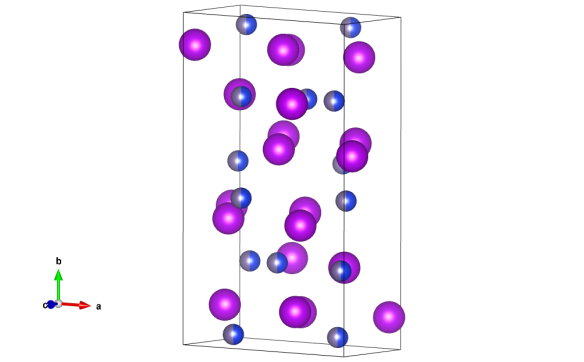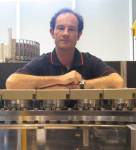Gd5Si2Ge2: Magneto gets cooler
What does it look like?

In the diagram above, the purple atoms are the gadolinium and the grey/blue atoms are mixed sites: germanium and silicon are randomly mixed 50/50. Image generated by the VESTA (Visualisation for Electronic and STructural analysis) software http://jp-minerals.org/vesta/en/
What is it?
It turns out that the whole 'X-Men' cartoon universe doesn’t just suffer from an obviously ludicrous premise. It also suffers from a subtly ludicrous premise: that Magneto needs sidekicks.
Gd5Si2Ge2 is a magneto-caloric material. That means there's a coupling between the magnetic properties of the material and its thermal properties. In fact, Gd5Si2Ge2 is technically referred to as a giant magneto-caloric material, which means that its magneto-caloric properties are really really big. Scientists can be very specific in their use of language.
Magneto-caloric materials can be used as refrigerators. The idea works like this: if you have a magnetized lump of the material, then it takes energy to demagnetize, and this energy comes out of the thermal motion. So instead of the compression-expansion cycle of an ordinary fridge, you have a magnetization-demagnetization cycle.
Magneto has always been able to bend or move any metal according to his will (even some that would appear to be non magnetic. Apparently no-one uses stainless steel or aluminium in the X-men universe). With magneto-caloric materials, he can make things hot and cold as well. With magneto-electric and magneto-optical materials, he's pretty much got all the bases covered and he can get rid of the incompetent mutant sidekicks.
Where does the structure come from?
The structure was published by Pecharskii and Gschneidner in 1997 [Journal of Alloys and Compounds 260 (1997), 98-106]. The same authors published the magnetocaloric properties in PRL [Physical Review Letters 78 (1997) 4494]. A few years later a different group published an article showing that, by adding a bit of iron, the magnetocaloric properties could be improved even more. They published in Nature. There's a lesson in there somewhere.






